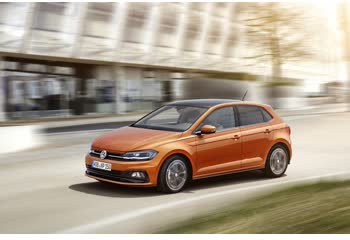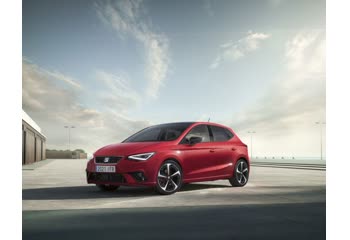Everything you need to know about specifications and performance - Volkswagen Polo 2021 - 1.0 TGI (90 Hp)

Overview:
What is the engine capacity of a Volkswagen Polo 2021?
The engine capacity of the Volkswagen Polo 2021 is 999.
Volkswagen Polo 2021 How many horsepower?
The engine power of the Volkswagen Polo 2021 is 90 Hp.
What is the Volkswagen Polo 2021 engine?
Volkswagen Polo 2021 engine is DBYA. (Click to see other cars using the same engine)
How much gasoline does a Volkswagen Polo 2021 consume?
The Volkswagen Polo 2021 consumes 3.3 kg/100 km liters of gasoline per 100 km
General:
Brand: Volkswagen
Model: Polo
Generation: VI (facelift 2021)
Modification (Engine): 1.0 TGI (90 Hp)
Start of production: 2021
End of production:
Powertrain Architecture: Internal Combustion Engine
Body type:Hatchback
Seats: 5
Doors: 5
Engine:
Engine systems: Start & Stop System
Power: 90 hp
Power per litre: 90.1 hp/l
Torque: 160 nm @ 1800-3800 rpm.
Engine Model/Code:DBYA
Engine displacement: 999
Number of cylinders: 3
Engine configuration: Inline
Number of valves per cylinder: 4
Fuel injection system: Direct injection and Multi-port manifold injection
Engine aspiration: Turbocharger, Intercooler
Valvetrain: DOHC
Engine oil capacity: 4 l
Engine layout: Front, Transverse
Cylinder Bore: 74.5 mm
Piston Stroke: 76.4 mm
Performance:
Combined fuel consumption (WLTP) (CNG): 3.7 kg/100 km
Fuel Type: Petrol / CNG
Fuel consumption (economy) - urban: 4.1 kg/100 km
Fuel consumption (economy) - extra urban: 2.8 kg/100 km
Combined fuel consumption (WLTP): 3.7 kg/100 km
Fuel consumption at Low speed (WLTP): 4.9 kg/100 km
Fuel consumption at Medium speed (WLTP): 3.6 kg/100 km
Fuel consumption at high speed (WLTP): 3.2 kg/100 km
Fuel consumption at very high speed (WLTP): 3.7 kg/100 km
Fuel consumption (economy) - urban (CNG): 4.1 kg/100 km
Fuel consumption (economy) - extra urban (CNG): 2.8 kg/100 km
Fuel consumption (economy) - combined (CNG): 3.3 kg/100 km
Fuel consumption (economy) - urban (CNG) (NEDC): 4.1 kg/100 km
Fuel consumption (economy) - extra urban (CNG) (NEDC): 2.8 kg/100 km
Fuel consumption (economy) - combined (CNG) (NEDC): 3.3 kg/100 km
Fuel consumption at Low speed (WLTP) (CNG): 4.9 kg/100 km
Fuel consumption at Medium speed (WLTP) (CNG): 3.6 kg/100 km
Fuel consumption at high speed (WLTP) (CNG): 3.2 kg/100 km
Fuel consumption at very high speed (WLTP) (CNG): 3.7 kg/100 km
Fuel consumption (economy) - combined: 3.3 kg/100 km
Emission standard: Euro 6d-ISC-Fcm
Acceleration 0 - 100 km/h: 12.3 sec
Acceleration 0 - 62 mph: 12.3 sec
Maximum speed: 183 km/h
Weight-to-power ratio: 13.7 kg/Hp, 73.2 Hp/tonne
Weight-to-torque ratio: 7.7 kg/Nm, 130.1 Nm/tonne
Acceleration 0 - 60 mph: 11.7 sec
Space:
Kerb Weight (kg): 1230
Max. weight (kg): 1680
Max. roof load: 75 kg
Max load (kg): 450
Trunk (boot) space - maximum: 1125 l
Trunk (boot) space - minimum: 351 l
dimensions:
Length: 4074 mm
Width: 1751 mm
Height: 1435 mm
wheelbase: 2555 mm
Front track: 1508-1526 mm
Rear (Back) track: 1492-1510 mm
Powertrain, Suspension and Brakes:
Drivetrain Architecture: The Internal combustion Engine (ICE) drives the front wheels of the vehicle.
Drive wheel: Front wheel drive
Number of gears and type of gearbox: 6 gears, manual transmission
Front brakes: Disc
Rear brakes: Drum
Assisting systems: ABS (Anti-lock braking system)
Steering type: Steering rack and pinion
Power steering: Electric Steering
Tires size: 185/65 R15; 195/55 R16
Wheel rims size: 5.5J x 15; 6.5J x 16
Front suspension: Independent type McPherson
Rear suspension: Torsion
See also

Other generation.
Its production began in 2018 until 2021

Same engine. (DBYA).
Its production began in 2021 until 2023

Same engine. (DBYA).
Its production began in 2019 until 2021

Same engine. (DBYA).
Its production began in 2021 until 2023

Write a comment